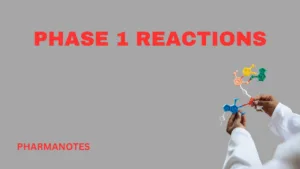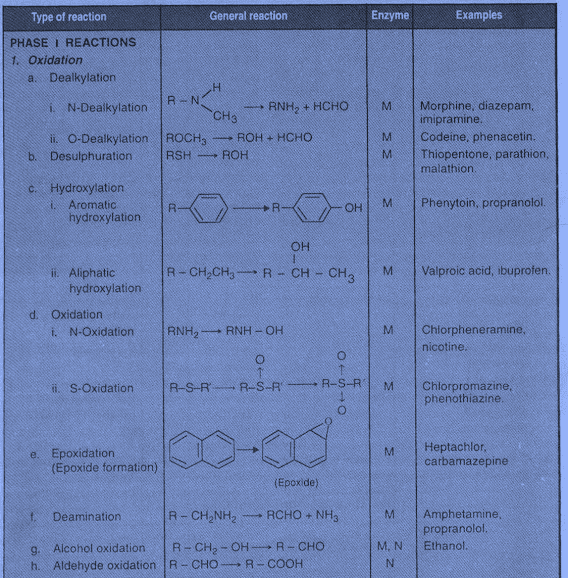Phase I Reactions

Phase I Reactions
Contents
- Phase I reactions Oxidation Reduction Hydrolysis
- Enzymes involved in phase I reactions
Intended learning outcomes
At the end of this lecture, student will be able to:
- Describe Phase I reactions and enzymes involved in first phase.
TYPES OF BIOTRANSFORMATION
Phase 1 reaction. (Non-synthetic phase).
- Change in drug molecule generally results in the introduction of a functional group into molecules or the exposure of new functional groups of molecules.
- Phase I (non-synthetic or non-conjugative phase) includes reactionswhich catalyse oxidation, reduction and hydrolysis of drugs.
- In phase I reactions, small polar functional groups like -OH, -NH2. -SH, -COOH, etc. are either added or unmasked (if already present) on the lipid soluble drugs so that the resulting products may undergo phase II reactions.
- It results inactivation, change or inactivation of drug.
Phase 1 Reaction
- Phase I metabolism is sometimes called a “functionalization reaction,” Results in the introduction of new hydrophilic functional groups to compounds.
Function: introduction (or unveiling) of functional group(s) such as –OH, –NH2, –SH, –COOH into the compounds.
Reaction types: oxidation, reduction, and hydrolysis
Enzymes:
Oxygenases and oxidases: Cytochrome P450 (P450 or CYP), Flavin containing monooxygenase (FMO), peroxidase, monoamine oxidase (MAO), alcohol dehydrogenase, aldehyde dehydrogenase, and xanthine oxidase.
Reductase: Aldo-keto reductase and quinone reductase.
Hydrolytic enzymes: esterase, amidase, aldehyde oxidase and alkyl hydrazine oxidase.
Enzymes that scavenge reduced oxygen: Superoxide dismutases, catalase,glutathione peroxidase, epoxide hydrolase, y-glutamyl transferase, dipeptidase, and cysteine conjugate β-lyase
Oxidation
- Oxidation by cytochrome P450 iso enzymes (microsomal mixed-function oxidases). Oxidation by enzymes other than cytochrome P450s.
Most of these are
(a) Oxidation of alcohol by alcohol dehydrogenase
(b) Oxidation of aldehyde by aldehyde dehydrogenase
(c) N-dealkylation by monoamine oxidase
- Oxidative reactions are most important metabolic reactions, as energy in animals is derived by oxidative combustion of organic molecules containing carbon and hydrogen atoms.
- The oxidative reactions are important for drugs because they increase hydrophilicity of drugs by introducing polar functional groups such as -OH.
- Oxidationof drugs is non-specifically catalysed by a number of enzymes located primarily in the microsomes. Some of the oxidation reactions are also catalysed by non- microsomal enzymes (e.g., aldehyde dehydrogenase, xanthine oxidase and monoamine oxidase).
- The most important group of oxidative enzymes are microsomal monooxygenases or mixed function oxidases (MFO).
- These enzymes are located mainly in the hepatic endoplasmic reticulum and require both molecular oxygen (O2) and reducing NADPH to effect the chemical reaction.
- Mixed function oxidase name was proposed in order to characterise the mixed function of the oxygen molecule, which is essentially required by a number of enzymes located in the microsomes.
- The term monooxygenases for the enzymes was proposed as they incorporate only one atom of molecular oxygen into the organic substrate with concomitant reduction of the second oxygen atom to water.
- The overall stoichiometry of the reaction involving the substrate RH which yields the product ROH, is given by the following reaction:
MFO
RH+O2+NADPH+H+ —————-► ROH+H2O+NADP+
- The most important component of mixed function oxidases is the cytochrome P-450 because it binds to the substrate and activates oxygen.
- The wide distribution of cytochrome P-450 containing MFOs in varying organs makes it the most important group of enzymes involved in the biotransformation of drugs.
PHASE I ENZYMES
- Cytochrome P450
- Monooxygenase (Cytochrome P450, P450, or CYP)
- Flavin-Containing Monooxygenase (FMO)
- Esterase
- Alcohol Dehydrogenase (ADH)
- Aldehyde Dehydrogenase (ALDH)
- Monoamine Oxidase (MAO)
Phase II Enzymes
- Uridine Diphosphate- Glucuronosyltransferase (UDPGT)
- Sulfotransferase (ST)
- N-Acetyltransferase (NAT)
- Glutathione S-Transferase (GST)
- Methyl Transferase
- Amino Acid Conjugation
The cytochrome P-450 ENZYMES
- Super family of haem-thiolate proteins that are widely distributed across all living creatures.
- The name given to this group of proteins because their reduced form binds with carbon monoxide to form a complex, which has maximum absorbance at 450 nm.
- Depending upon the extent of amino acid sequence homology, the cytochrome P-450 (CYP) enzymes superfamily contains a number of isoenzymes, the relative amount of which differs among species and among individuals of the same species.
- These isoenzymes are grouped into various families designated by Arabic numbers 1, 2, 3 (sequence that are greater than 40% identical belong to the same family), each havingseveral subfamilies designated by Capital letter A, B, C, while individual isoenzymes are again allotted Arabic numbers 1.2,3 (e.g., CYP1A1, CYP1A2, etc.).
Role of Cyp Enzymes in Hepatic Drug Metabolism
• In human beings, of the 1000 currently known cytochrome P-450s, about 50 are functionally active. These are categorised into 17 families, out of which the isoenzymes CYP3A4 and CYP2D6 carry out biotransformation of largest number of drugs.
Participation of the CYP Enzymes in Metabolism of Some Clinically Important Drugs
| CYP Enzyme | Examples of substrates |
| 1A1 | Caffeine, Testosterone, R-Warfarin |
| 1A2 | Acetaminophen, Caffeine, Phenacetin, R-Warfarin |
| 2A6 | 17-Estradiol, Testosterone |
| 2B6 | Cyclophosphamide, Erythromycin, Testosterone |
| 2C-family | Acetaminophen, Tolbutamide (2C9); Hexobarbital, S- Warfarin (2C9,19); Phenytoin, Testosterone, R- Warfarin, Zidovudine (2C8,9,19); |
| 2E1 | Acetaminophen, Caffeine, Chlorzoxazone, Halothane |
| 2D6 | Acetaminophen, Codeine, Debrisoquine |
| 3A4 | Acetaminophen, Caffeine, Carbamazepine, Codeine, Cortisol, Erythromycin, Cyclophosphamide, S- and R- Warfarin, Phenytoin, Testosterone, Halothane, Zidovudine |
Reduction
Enzymes responsible for reduction of xenobiotics require NADPH as a cofactor.
Substrates for reductive reactions include azo- or nitro compounds, epoxides, heterocyclic compounds, and halogenated hydrocarbons:
(a) Azo or nitro reduction by cytochrome P450;
(b) Carbonyl (aldehyde or ketone) reduction by aldehyde reductase, aldose reductase, carbonyl reductase, quinone reductase
(c) Other reductions including disulfide reduction, sulfoxide reduction, and reductive dehalogenation.
• The acceptance of one or more electron(s) or their equivalent from another substrate.
• Reductive reactions, which usually involve addition of hydrogen to the drug molecule, occur less frequently than the oxidative reactions.
• Biotransformation by reduction is also capable of generating polar functional groups such as hydroxy and amino groups, which can undergo further biotransformation.
• Many reductive reactions are exact opposite of the oxidative reactions (reversible reactions) catalysed cither by the same enzyme (true reversible reaction) or by different enzymes (apparent reversible reactions).
• Such reversible reactions usually lead to conversion of inactive metabolite into active
Hydrolysis
• Esters, amides, hydrazides, and carbamates can be hydrolyzed by various enzymes.
• The hydrolytic reactions, contrary to oxidative or reductive reactions, do not involve a change in the state of oxidation of the substrate, but involve the cleavage of drug molecule by taking up a molecule of water.
• The hydrolytic enzymes that metabolise drugs are the ones that act on endogenous substances, and their activity is not confined to liver as they are found in many other organs like kidneys, intestine, plasma, etc.
• A number of drugs with ester, ether, amide and hydrazide linkages undergo hydrolysis. Important examples are cholinesters, procaine, procainamide, and pethidine.
Hydrolysis Reactions
Summary
• Phase I (non-synthetic or non-conjugative phase) includes reactions which catalyze oxidation, reduction and hydrolysis of drugs.
• In phase I reactions, small polar functional groups like-OH, -NH2. -SH, -COOH, etc. are either added or unmasked (if already present) on the lipid soluble drugs so that the resulting products may undergo phase II reactions.
• The name given to this group of proteins because their reduced form binds with carbon monoxide to form a complex, which has maximum absorbance at 450 nm.
• Depending upon the extent of amino acid sequence homology, the cytochrome P-450 (CYP) enzymes superfamily contains a number of isoenzymes, the relative amount of which differs among species and among individuals of the same species.






